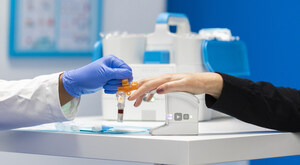FRANKLIN LAKES, N.J., Jan. 26, 2022 /PRNewswire/ -- BD (Becton, Dickinson and Company) (NYSE: BDX), a leading global medical technology company, today announced the outcome of a peer-reviewed study published in the journal of Obstetrics & Gynecology that showed molecular diagnostics could improve the accuracy of vaginitis diagnosis and lead to more appropriate and timely treatment decisions.
In the paper, Performance of a Vaginal Panel Assay Compared With the Clinical Diagnosis of Vaginitis — which reports the findings from a BD clinical trial — the three causes of vaginitis (bacterial vaginosis [BV], vulvovaginal candidiasis [VVC] or Trichomonas vaginalis [TV]) were studied to compare clinician assessment with results from a molecular test. The study found that compared to the molecular test, clinician diagnosis missed 45.3 percent of positive cases (180 of 397) and incorrectly identified 12.3 percent of negative cases as positives (123 of 879).
The study was also selected for inclusion in the Obstetrics & Gynecology Journal Club, which selects two to three studies per issue to provide medical students an opportunity to review landmark papers and help them build a foundation for evidence–based practice.
Between 6 million and 10 million health care visits by women in the U.S. are related to symptoms of vaginitis.1,2 Although vaginitis is a common condition, diagnosis of its usual causes3,4 (BV, VVC, or TV) in women of reproductive age is not standardized.
"A misdiagnosis means inappropriate treatment recommendations — either undertreatment or overtreatment," said study co-author Molly Broache, medical science liaison for Integrated Diagnostic Solutions at BD. "A woman might be asked to make return visits to the doctor that aren't necessary, or she may develop antimicrobial resistance because she's taking antibiotics she doesn't actually need."
The study compared clinician diagnosis of vaginitis to results of a vaginal panel assay performed on the BD MAX™ System, an FDA-market authorized molecular test that uses nucleic acid amplification to detect the microbial causes of BV, VVC, and TV. The study involved 489 symptomatic participants. Participants received a clinical diagnosis and had a vaginal assay swab collected during their visit. Swabs were sent to a separate testing facility and later compared to clinician diagnosis.
"We really do women a medical disservice when we do not use the best tools we have available to diagnose the cause or causes of the symptoms that drove them to seek health care," said study co-author Barbara Van Der Pol, Ph.D., MPH and Professor of Medicine and Public Health. "Too many infections are caused by multiple organisms for us to think that we can correctly identify them without high-quality diagnostic testing. The data in this paper confirms that we owe women the best options available and clinical observations are not sufficient."
The BD MAX™ Vaginal Panel Assay can help address the limitations of clinical diagnosis and can help improve diagnostic accuracy. This automated assay has a shorter turnaround time (approximately three hours to run between two and 24 samples simultaneously), so same-day results are possible if the clinician has the instrument available on site. Assay automation is designed to decrease variability and subjectivity, thereby helping to increase diagnostic accuracy.
"When a woman is misdiagnosed either way — told that she doesn't have vaginitis but actually does or told that she does have vaginitis but is not infected — it creates hardship and risk," said Broache. "Women deserve better."
About the BD MAX™ Vaginal Panel
The BD MAX™ Vaginal Panel was market authorized as an in vitro diagnostic in October 2016 and it is utilized on the BD MAX™ System. The assay detects microorganisms responsible for Bacterial Vaginosis (BV), Trichomoniasis (TV) and Vulvovaginal Candidiasis (VVC), also known as a yeast infection, which are the most common infectious causes of vaginitis.3,4,6 The in vitro diagnostic (IVD) assay is the first multiplex, real-time polymerase chain reaction (PCR) assay authorized by FDA for the detection of microorganisms responsible for both vaginitis and vaginosis in women that exhibit symptoms of vaginal infections. BV diagnosis is challenging, as it is caused by bacterial imbalances in the vagina. To address this challenge, the BD MAX™ Vaginal Panel has a unique algorithm that determines the ratio of healthy versus unhealthy bacteria, helping to improve BV diagnosis.
About the BD MAX™ System
The BD MAX™ System is a fully integrated, automated platform that performs nucleic acid extraction and real-time polymerase chain reaction (PCR), providing results for up to 24 samples across multiple syndromes in approximately three hours. The BD MAX™ System offers laboratories in vitro diagnostic assays that span women's health and sexually transmitted infections, enteric infections, and healthcare-associated infections, along with an open-system capability and reagents.
About BD
BD is one of the largest global medical technology companies in the world and is advancing the world of health by improving medical discovery, diagnostics and the delivery of care. The company supports the heroes on the frontlines of health care by developing innovative technology, services and solutions that help advance both clinical therapy for patients and clinical process for health care providers. BD and its 75,000 employees have a passion and commitment to help enhance the safety and efficiency of clinicians' care delivery process, enable laboratory scientists to accurately detect disease and advance researchers' capabilities to develop the next generation of diagnostics and therapeutics. BD has a presence in virtually every country and partners with organizations around the world to address some of the most challenging global health issues. By working in close collaboration with customers, BD can help enhance outcomes, lower costs, increase efficiencies, improve safety and expand access to health care. For more information on BD, please visit bd.com or connect with us on LinkedIn at www.linkedin.com/company/bd1/ and Twitter @BDandCo.
References:
1. Owen MK, Clenney TL. Management of vaginitis. Am Fam Physician 2004;70:2125-32.
2. Eckert LO. Acute vulvovaginitis. N Engl J Med 2006;355:1244-52. Doi: 10.1056/nejmcp053720
3. Koumans EH, Sternberg M, Bruce C, et al. The prevalence of bacterial vaginosis in the United States, 2001-2004: associations with symptoms, sexual behaviors, and reproductive health. Sexually Transmitted Diseases. 2007;34:864–9.
4. Sutton M, Sternberg M, Koumans EH, et al. The prevalence of Trichomonas vaginalis infection among reproductive-age women in the United States, 2001-2004. Clinical Infectious Diseases. 2007;45:1319–26.
5. Clinical Infectious Diseases, Volume 72, Issue 9, 1 May 2021, Pages 1544–1545, https://doi.org/10.1093/cid/ciaa267
6. Yano J, Sobel JD, Nyirjesy P, et al. Current patient perspectives of vulvovaginal candidiasis: incidence, symptoms, management and post-treatment outcomes. BMC Women's Health. 2019;19(1):48.
Contacts:
Media Mela Sera, APR BD Public Relations 443.824.8012 |
Investors: Francesca DeMartino SVP, Head of Investor Relations 201.847.5743 |
SOURCE BD (Becton, Dickinson and Company)

WANT YOUR COMPANY'S NEWS FEATURED ON PRNEWSWIRE.COM?
Newsrooms &
Influencers
Digital Media
Outlets
Journalists
Opted In






Share this article